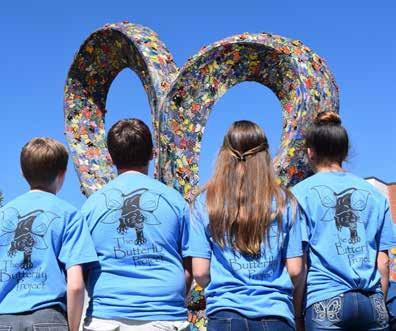
4 minute read
A Morning With The Levine JCC Butterfly Project Volunteers
January 2024
By Emily Russell
On most Tuesday, Wednesday or Thursday mornings from mid-October to mid-May the Sam Lerner Center for Cultural Arts is set up with theater-style seating, for a Levine JCC Butterfly Project workshop, waiting for students to arrive from a local middle school. The Levine JCC Butterfly Project workshops were developed as a call to action using education, the arts, and memorial making. The workshops are interactive sessions that use the lessons from the Holocaust to combat prejudice, stereotyping, and discrimination. These lessons are conveyed through engaging with a Holocaust survivor, participating in an interactive discussion using the ADL Pyramid of Hate, painting ceramic butterflies to memorialize specific child victims and visiting the Margaret and Lou Schwartz Butterfly Garden Holocaust Memorial.
Ed, a twice-weekly volunteer, prepares Holly and Hal Levinson Family Place, lovingly referred to as the “painting room”. Fellow volunteers gather supplies: paints, brushes, plates, butterflies, certificates, water cups, pencils, and Sharpies. Susie ensures chair placement, while Ira lays out table cloths. Carole readies the paints, and Ellen sets out ceramic butterflies and Holocaust victim certificates, each bearing the name of a child victim of the Holocaust and the poignant words zikaron v’tikvah (remembrance and hope). Susan and Stu distribute these materials to seats, preparing for two rounds of students. Sally Ann, Bonnie, and Etti complete the setup with paintbrushes, pencils, water containers, Sharpies, and paper towels. A corner with a hairdryer is designated for drying butterflies, and a box of bookmarks, one per student, is prepared for distribution.
The room is set.
The volunteers at the Levine JCC’s Butterfly Project are already immersed in lively conversations about life and current events as they anticipate the students’ arrival. Jane waits as the students have Q&A with either Irving Bienstock or Suly Chenkin.
During the part of the workshop called “What’s in a Name”, students explore the significance of names in the context of identity and the Holocaust. Volunteers, like Carole, and Ellen, assist in this reflective process. They ensure each student understands the importance of the names on their certificates, linking them to the Holocaust’s victims. The volunteers, including Susan, Stu, Sally Ann, Bonnie, and Etti, engage with students, helping them understand the names on their butterflies and how to pronounce them, saying them out loud as a way to memorialize and honor those children. Even if they are unsure about the pronunciation, they are encouraged to do the best they can because they may be the only one to speak that child’s name out loud in 75-80 years. The volunteers explain the importance of a name to ones individuality and how the Nazis took away Jewish people’s names to erase their identities.
As the painting begins, Essy and Mary gather the completed butterflies for drying by Wendi. Meanwhile, Matthew prepares to take the students to the garden, where one of them will read “The Last Butterfly” by Pavel Friedman, reinforcing the Holocaust’s lessons and the importance of preventing such atrocities.
Post-painting, the volunteers, including Ramit, Marsha, and Judy, swiftly reset the room for the next group. Elyse and Rikki meticulously prepare the tables with fresh supplies. Rochelle carefully places the last dried butterfly in the storage box as the second group of students arrive, ready to repeat the meaningful experience.
And the volunteers do it all again.
This time Linda takes the students to the garden. They discuss why butterflies were chosen to represent the children and she points out a particular butterfly in the memorial painted by a local survivor that says “Best Present to be Free”.
Meanwhile back in the painting room, volunteers focus on drying and packing butterflies, cleaning brushes, and cleaning the room. Lisa returns the butterflies to the school, passing students engrossed in their final lesson about positive change.
The LJCC Butterfly Project’s volunteers are an integral part of the success of the program. Without them we could not have painted over 60,000 butterflies in the last 14 years.
Some volunteers come weekly, some monthly, some on occasion but they all do it for the same reason. "Seeing how curious and creative the kids are" is the best reason to come for Mary and all of our volunteers agree.
By learning about the past, participants can act responsibly today to create a more peaceful future.
The LJCC Butterfly Project will host its Annual Community Day on Feb. 25 at 2p.m., where all are welcome to participate in this profound experience, regardless of age. If you would like to learn more visit Charlottejcc.org/pages/the-butterfly-project/.











